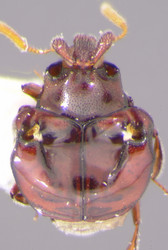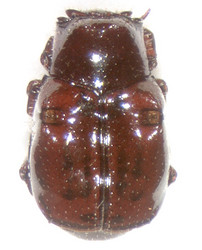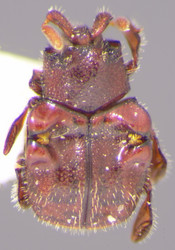Eucurtiopsis
Michael S. Caterino- Eucurtiopsis adebratti Dégallier & Caterino
- Eucurtiopsis brendelli (Caterino)
- Eucurtiopsis carinatus (Caterino)
- Eucurtiopsis chungi Dégallier & Caterino
- Eucurtiopsis danielssoni Dégallier & Caterino
- Eucurtiopsis elongatus (Caterino)
- Eucurtiopsis gomyi Dégallier & Caterino
- Eucurtiopsis hammondi (Caterino)
- Eucurtiopsis hiranoi Nishikawa
- Eucurtiopsis kanaari Dégallier & Caterino
- Eucurtiopsis marinae Dégallier & Caterino
- Eucurtiopsis mazuri Dégallier & Caterino
- Eucurtiopsis mirabilis Silvestri
- Eucurtiopsis ohtanii (Sawada)
- Eucurtiopsis tishechkini Dégallier & Caterino
- Eucurtiopsis reichenspergeri Dégallier & Caterino
- Eucurtiopsis viennai Dégallier & Caterino
- Eucurtiopsis zecki Dégallier & Caterino
Introduction
Eucurtiopsis is among the larger chlamydopsine genera, with nearly 20 species (Dégallier & Caterino, 2005). It is also quite widespread, ranging from Indonesia northward through insular Malaysia, the Philippines (Tishechkin & Caterino, in press), Taiwan, and Japan. One of its Japanese species has been reported from the nests of Pheidole ants (Nishikawa, 1995), and it is possible that this is a common host for members of the genus.
Though its name may imply otherwise, Eucurtiopsis is not closely related to Eucurtia, but instead belongs in the 'hidden scutellum' group of Chlamydopsinae, along with Pheidoliphila, Orectoscelis, and a few other small genera. The monophyly of the genus was not supported in a recent analysis (Caterino & Dégallier, 2007).
Characteristics
Most species of Eucurtiopsis are readily recognized. They tend to have broad elytra, extending laterad beyond the pronotum, with prominent, transversely incised elytral trichomes. Most species also have paired pronotal tubercles.
References
Caterino. M. S. and Dégallier, N. 2007. A review of the biology and systematics of Chlamydopsinae. Invertebrate Systematics 21:1-28.
Dégallier, N., and Caterino, M. S. 2005. Notes taxonomiques sur les Chlamydopsinae et descriptions d’espèces nouvelles. - I. Genres Ceratohister Reichensperger, Eucurtiopsis Silvestri et Orectoscelis Lewis. Bulletin de la Societe Entomologique de France 110:299–326.
Nishikawa, M. (1995). Notes on chlamydopsine histerid beetles of Japan, with description of a new species. Elytra 23, 257–261.
Tishechkin, A. K, and Caterino, M. S. (in press). Description of the first Chlamydopsinae from the Philippines. Zootaxa.
Information on the Internet
- Color images of all species. Supplement to descriptive paper, hosted by M. Caterino and the Santa Barbara Museum of Natural History.
Title Illustrations

| Scientific Name | Eucurtiopsis marinae |
|---|---|
| Specimen Condition | Dead Specimen |
| Identified By | Michael S. Caterino |
| Image Use |
 This media file is licensed under the Creative Commons Attribution-ShareAlike License - Version 3.0. This media file is licensed under the Creative Commons Attribution-ShareAlike License - Version 3.0.
|
| Copyright |
©

|
| Scientific Name | Eucurtiopsis tishechkini |
|---|---|
| Specimen Condition | Dead Specimen |
| Identified By | Michael S. Caterino |
| Image Use |
 This media file is licensed under the Creative Commons Attribution-ShareAlike License - Version 3.0. This media file is licensed under the Creative Commons Attribution-ShareAlike License - Version 3.0.
|
| Copyright |
©

|
| Scientific Name | Eucurtiopsis kanaari |
|---|---|
| Identified By | Michael S. Caterino |
| Image Use |
 This media file is licensed under the Creative Commons Attribution-ShareAlike License - Version 3.0. This media file is licensed under the Creative Commons Attribution-ShareAlike License - Version 3.0.
|
| Copyright |
©

|
About This Page

Santa Barbara Museum of Natural History, Santa Barbara, California, USA
Correspondence regarding this page should be directed to Michael S. Caterino at
Page copyright © 2007
 Page: Tree of Life
Eucurtiopsis .
Authored by
Michael S. Caterino.
The TEXT of this page is licensed under the
Creative Commons Attribution License - Version 3.0. Note that images and other media
featured on this page are each governed by their own license, and they may or may not be available
for reuse. Click on an image or a media link to access the media data window, which provides the
relevant licensing information. For the general terms and conditions of ToL material reuse and
redistribution, please see the Tree of Life Copyright
Policies.
Page: Tree of Life
Eucurtiopsis .
Authored by
Michael S. Caterino.
The TEXT of this page is licensed under the
Creative Commons Attribution License - Version 3.0. Note that images and other media
featured on this page are each governed by their own license, and they may or may not be available
for reuse. Click on an image or a media link to access the media data window, which provides the
relevant licensing information. For the general terms and conditions of ToL material reuse and
redistribution, please see the Tree of Life Copyright
Policies.
- First online 15 July 2007
- Content changed 15 July 2007
Citing this page:
Caterino, Michael S. 2007. Eucurtiopsis . Version 15 July 2007 (under construction). http://tolweb.org/Eucurtiopsis/9255/2007.07.15 in The Tree of Life Web Project, http://tolweb.org/












 Go to quick links
Go to quick search
Go to navigation for this section of the ToL site
Go to detailed links for the ToL site
Go to quick links
Go to quick search
Go to navigation for this section of the ToL site
Go to detailed links for the ToL site